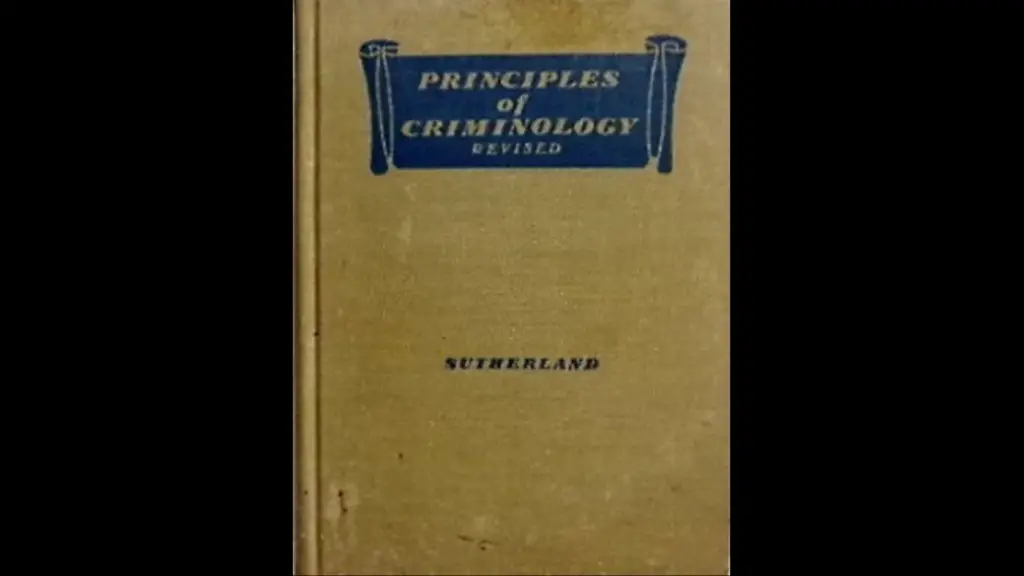Differential association theory was formulated by Edwin Sutherland. In 1939, he published an important book named “Principles of Criminology” in which he described the theory. In a nutshell, the theory of differential association says that offenders commit crime because they have learned it from other people in intimate, personal groups.

Table of Contents
Criminal Behavior is Learned
According to Sutherland, all important forms of human behavior, including criminal behavior, are learned. Just like you learn how to ride a bike, read, or cook, you also learn how to commit crime. And so, if we want to understand crime and criminal behavior, we need to look at how people learn things.
When we look at the way in which people learn things, one thing that is crucial is who you learn from. The people around us have different opinions about what is right and what is wrong. Some people believe that breaking the law is wrong, but others do not. Thus, it matters who you surround yourself with, or who you associate with. If you have more contact with people who believe that it’s wrong to break rules, you will be less likely to commit crime yourself. On the other hand, if you have more contact with people who believe it’s OK to break rules, you will be more likely to commit crime. That is, in short, the general idea of differential association theory.

The Nine Fundamental Principles of Differential Association Theory
Differential association theory contains nine fundamental principles, and I’ll briefly go through them all.
- The first principle is that criminal behavior is learned. According to Sutherland, the “born criminal” does not exist. Criminal behavior is not something that is genetic nor do offenders simply come up with criminal behavior. Instead, they learn it.
- How do they learn it? People learn criminal behavior by interacting with other people. So they need to have active contact with others in order to learn.
- However, learning does not take place in just any type of social interaction. Instead, people learn criminal behavior in intimate personal groups. According to Sutherland, people don’t learn so much in large groups or through the media, such as by watching violent movies and games. Instead, in his view, it’s about intimate, personal groups. More specifically, family and friends are the main influences on people’s life.
- The fourth principle is that learning criminal behavior includes learning the techniques of committing crime as well as the motives, drives, rationalizations, and attitudes. In other words, it’s not enough to simply imitate what other offenders do, the techniques they use to commit crime so to speak. People also need to learn justifications for engaging in crime and develop the right mental attitude toward crime.
- Fifth, the motivation to commit crime comes from whether we view legal codes as favorable or unfavorable. In some cultures or subcultures, like for example in some neighborhoods or in some youth gangs, it is believed that rules and laws are there to be broken. In other neighborhoods or groups, most people believe that rules should be obeyed. And so, how we think about rules and laws, namely whether we think they should be followed or not, influences whether or not we commit crime.
- The key to differential association theory is that a person becomes delinquent because of an excess of definitions favorable of breaking the law over definitions favorable of obeying the law. In other words, if a person is exposed to more ideas that breaking the law is right or OK than to ideas that breaking the law is wrong, they will become delinquent. On the other hand, if a person is confronted with more ideas that one should obey the law than ideas that they should break it, they will not become delinquent.
- Differential association may vary in frequency, duration, priority, and intensity. Some people have frequent contact with people who commit crime and some may not. Some people may also have longer associations, meaning a longer duration of contact, with people who think that one should break the law. When it comes to “priority”, what is meant is that the behavior that children learn when they are small may persist throughout life. So if they learn antisocial behavior early in life, that may persist until old age. Instead, if they learn to obey the rules early in life, that may persist, too. Finally, the intensity of differential associations refers to the status of the person you learn from. If that person holds more status, you’re more likely to learn from them.
- Learning criminal behavior involves all of the mechanisms that are involved in other types of learning. This principle means that criminal behavior is not just the result of simple imitation but involves other parts of learning as well. In order to learn, people need to listen, observe, understand, practice, and so on.
- Finally, criminal behavior is not explained by general needs and values, because noncriminal behavior is an expression of the same needs and values. This final and somewhat complicated principle says that the way in which other theories explain criminal behavior is not valid according to Edwin Sutherland. According to him, this is the case, because these other theories both explain criminal and non-criminal behavior. To make this a little clearer, let’s consider money. Some say that offenders have financial motives for committing crime. According to Sutherland, that is not a good explanation at all, because there are lots of people who make money by working a regular job and who do not commit crime. So, he argues, money motivates both criminal and non-criminal behavior, so it can’t really explain criminal behavior.
In short, these nine principles form the backbone of differential association theory and explain what the fundamental idea behind it is.

Contribution of Sutherland’s Differential Association Theory to Criminology and the Sociology of Crime
Differential association theory has been very influential in criminology and the sociology of crime. One of the important things it has achieved is that it managed to move sociological and criminological theory away from the dominant perspectives at that time. For example, those dominant perspectives said that people commit crime because of the neighborhood they live in, or because of their personality, or because of their social class. Instead, differential association theory says that criminal behavior is learned.

Criticism of Sutherland’s Differential Association Theory
But despite its important contribution, Sutherland’s differential association theory has also received its fair share of criticism. Some people think that its concepts are too vague and unspecific. Another criticism has been that the theory doesn’t explain why people who are not surrounded by criminal associations still commit crime or why other people, who are surrounded by criminal associations, do not commit crime. The theory was therefore later modified and worked into other social learning theories.
Nevertheless, Edwin Sutherland’s differential association theory is one of the most important theories of crime. It says that crime is learned from others in intimate, personal groups. And in doing so, it has established itself as an important theory in criminology and sociology.
Further Reading
An overview of the theory and support for it can be found here:
Matsueda, R. L., & Lanfear, C. C. (2007). Differential association theory. The Blackwell Encyclopedia of Sociology, 1-3. https://doi.org/10.1002/9781405165518.wbeos1636

